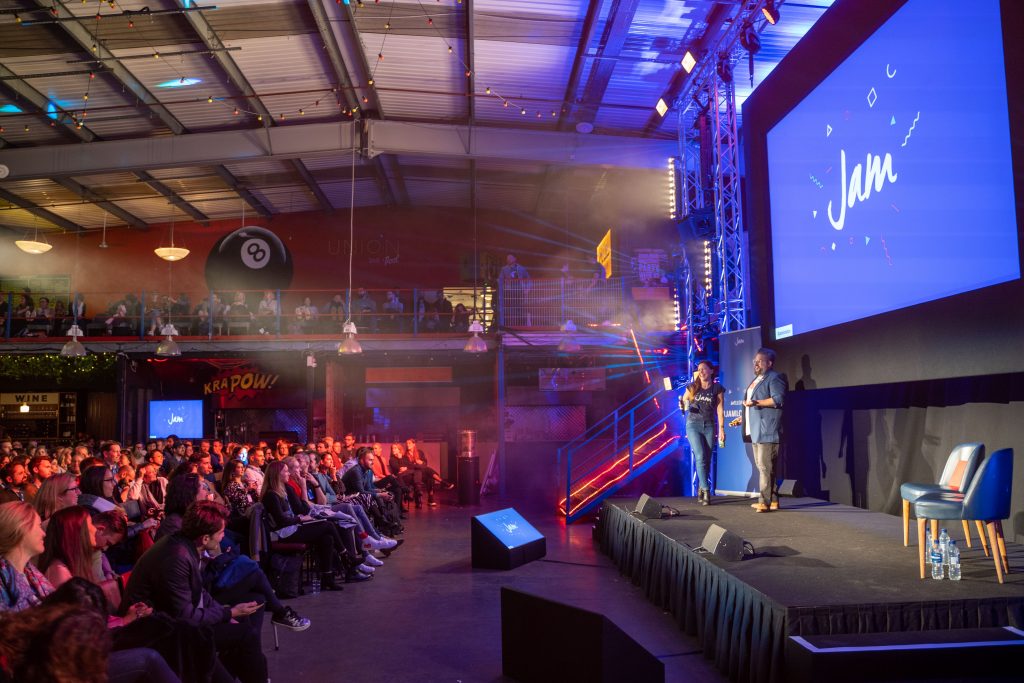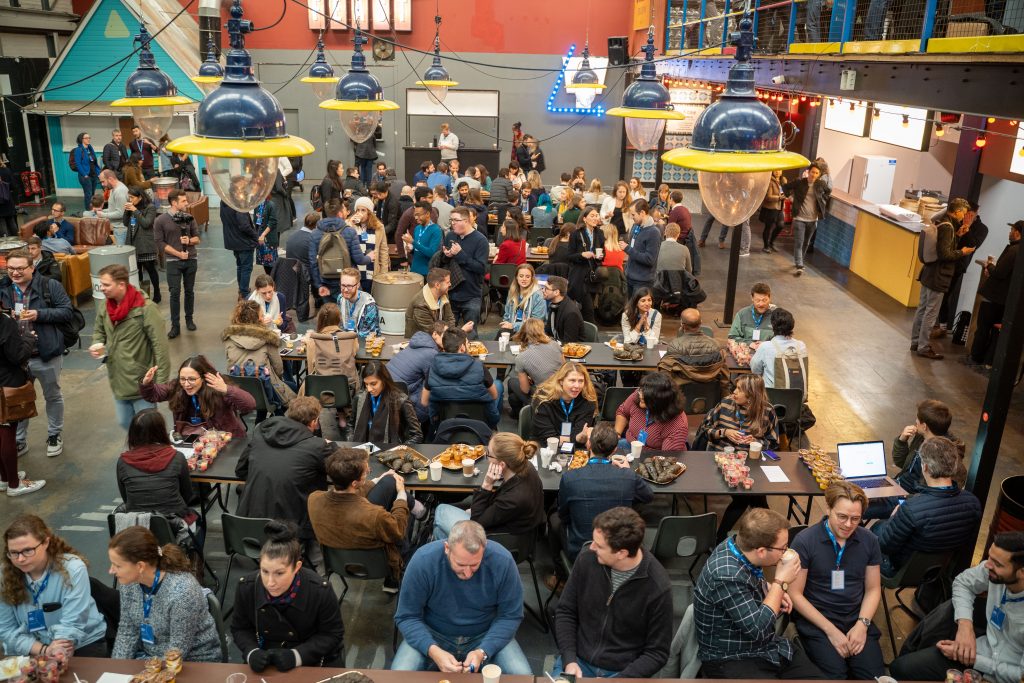A few weeks ago, some of us at Caplin went to Jam London 2019. The location was Hawker House just around the corner from Canada Water, a cool venue very different from the typical dull conference halls we seem to spend a lot of time in. And that flowed through to the talks, which were far more sharing stories than the regular monologues one seems to encounter.
After finding our seats, we settled in for some great talks.

Communication Revolution
Jeff Gardner from Intercom started with a talk about the importance of narrative storytelling in the product role. The fact is, when you give lectures, your audience only remembers half of what you say at best. Conversely, humans are remarkably good at remembering stories and narratives. When you make people feel and you engage with them at an emotional level, you will be able to make your arguments more effective.
Create a story, keep it short and focus on the feelings. Think about who the people are who are impacted and how they will feel. This will help your audience to understand how important certain features or products are. For example, telling people about how much time they might save by you creating a better tax management product is unlikely to move anyone, but if you explain how much people dread doing their taxes, or how time saved can be better spent with one’s family, you can better explain the importance of your products.
Jeff Gardner warns, however, that emotional arguments are only one factor in the decision making process, so make sure you have the data to backup your claims.
Sabrina Rzepka from BMW also had some very interesting advice about helping others in your company understand your vision. Too many times do we spend hours creating 50 slide decks, then get 20 people in a room and subject them to a 2 hour meeting. And because they have no context, it is all wasted as they get hung up on the details rather than the big picture.
The solution? Create a paper movie! Basically, just grab a video device, a sheet of paper and a sharpie. You should be able to sketch out the core problem, who the actors are, and your proposed solution in just an hour or so. Speed this video up to 3 minutes total, and send it out.
People will watch the video, understand what you are trying to do, and then the details can be thrashed out in more precise, dedicated meetings, once everyone has the context. A great idea that I would love to try out.

Research Review
Jamie Nicholsan from Instagram, on the other hand, had some very interesting thoughts on how to orient your thinking around your customers, rather than your company.
During his time at Instagram, Jamie spent a lot time doing direct research: getting into the field and asking questions directly to customers about how they interact with Instagram and each other. This ultimately gave him answers to his questions, but more importantly showed him that he was asking the wrong questions entirely.
One interesting note he had was that when you have a product with a very large customer base, you will very quickly get to a point where the majority of your customers think your product is okay and don’t want any changes. This is the point when you need to narrow your research base to focus on your more extreme customers. These are the people who feel most passionately about your product and can help you find a new direction that works for all your customers.
This direct research allowed Jamie’s team to gain keen insight into how people are willing to interact with each other online, from perhaps just viewing posts of a stranger, to adding an emoji of an acquaintance all the way to commenting on a post of a friend. This allowed them to spot a gap where no feature existed to bridge two relationship levels, which encouraged Instagram to create the “vote” feature, even though no customer precisely asked for it. A good example of delivering a car rather than faster horses to fulfill a customer’s need.
The principle of focusing on a specific audience in order to start gathering feedback and user insights applies to all. A common theme throughout the talks was on the value of early testing with your users to gather insights about their needs and improve your processes. From Instagram focusing on their extreme customers, to Ocado trialling their logistics system in house with lunch delivery services before rolling it out to large vendors — no company should think they can’t reap the benefits of user testing.
One final note was Jamie’s note on personas. For a long time now I have questioned the value of creating personas with lots of extraneous data that isn’t related to how your customers interact with you. Jamie agreed that who your customer is (normally captured in a persona), isn’t as important as what they want or how they feel.
Jamie’s advice was that rather than basing your product decisions around ‘personas’, base your decisions around ‘stories’ that you have gleaned from direct research. You might hear the same story from wildly different users, who would never share a persona, but share a ‘needs archetype’. These shared stories are far more valuable than what their salary is and what car they drive.
Kaarel Kuddu had some very interesting notes on the counter-intuitive dangers of being too data driven and listening to your customers too much. At Transferwise, they were looking at what payments locations they should next role out to, and they used a variety of processes unsuccessfully.
Using the most comprehensive data available, from the World Bank, they determined that Japanese Yen was one of the most traded currencies. However, after implementing this, they realised that while USDJPY and EURJPY are huge in terms of international business, their customers, sending small payments, were less interested in it. Or as Kaarel summarized: ‘Don’t just believe micro and macro economic data over what users actually want’.
Pivoting, they decided to add a ‘request currency’ feature to their website. They very quickly found that their customers most desired to transfer to Colombian Pesos, which they swiftly implemented, patting themselves on the back for being driven by customer feedback. However, once implemented, almost no customers used the feature. Why? Well it turns out potential customers mostly wanted to transfer money for, er, let’s say, illicit purposes. The protections added to prevent precisely this from occurring (such as scanning users’ passports) dissuaded potential users from engaging.
What is the solution? Kaarel recommended using data in combination with a deep understanding of the reasons behind the data to make decisions. Data is not a subsititute for knowledge of the domain.
One final amusing note that he mentioned was that internationalisation is not localisation. You can translate the text of your website all you want, but that won’t necessarily get your point across to other locations.
Transferwise added a picture of Richard Branson on their website, who had recently become an investor. This played very well in the UK and US where conversion increased rapidly, but less well in Germany (where he is considered to party a bit too much), where conversion actually went down! Instead, they decided to add a government sponsored ‘TüV certificate’, which was found to be much more trustworthy in Germany.
This reminds me of one presentation I once made to a customer abroad. Thinking it would be nice to add an image of their city to my slide deck, I promptly added a photo of their city skyline. Only once it was too late did I discover that the most prominent skyscraper in the photo housed their most bitter competitors. Whoops! Always make sure you understand how things will appear to others!

Introspective Hour
When it comes to simple concepts with big impact, I think the standout of the day was Matt Lemay, who used the concept of One Page One Hour, to encourage us all to work more collaboratively and less independently, create less busywork and drive better outcomes. The gist is that if you are thinking about a new idea, spend no more than one hour and one sheet of paper to work it through. Once this limit is up, find a person or team to collaborate on the idea further with. Simple idea, and a valuable one. ‘Oh, and on that topic,’ he added, ‘Stop using the word agile. Agile is a made up thing. Find a way to make it useful or move on.’ Good advice for us all.
But the standout talk of the day was from Susana Lopes from Onfido. Her talk on ‘You didn’t fail, your product did’ was truly excellent and loved by all those in attendance.
She highlighted the fact that when we look around we normally only see people’s successes, the projects that went well and the things they achieved. But we also all have ‘shadow careers’ representing all the failures we have experienced.
And when your products fail, it is all too easy to think that you yourself are a failure. It is important to realise that just because things failed, their failure does not reflect on yourself as a person. It is important to pick yourself up, dust yourself down, learn what you can from the experience and press onwards.
And it is important not to forget how important experience is. We all want to be great straight away, to not make any mistakes from day one. But the fact is you need to fail again and again in order to get better and better. Embrace it.
And just in case you start thinking this is all good news, and that your experience will mean fewer mistakes as you progress, Susanna reminds us that as we move forward, we will be given bigger and bigger opportunities, and as the opportunities get bigger, the failures will be more likely, and more catastrophic. You simply can’t escape it, your shadow career is going to follow you forever!
A fantastic talk, and one I recommend everyone spends the time to watch.
Conclusion
All in all, a fantastic conference, with lots of interesting talks and attendees. The venue was lovely (if a little cold where I was sitting) and the food was fantastic. We will definitely be back next year!
